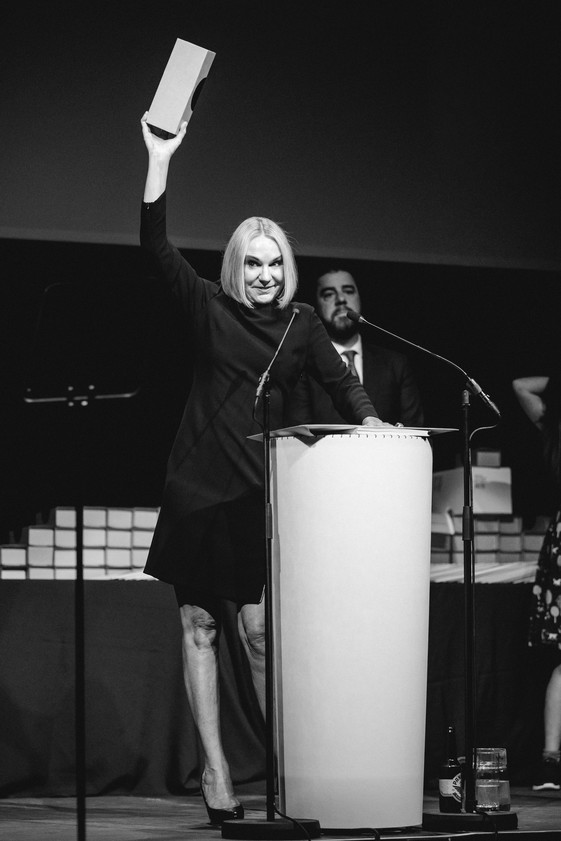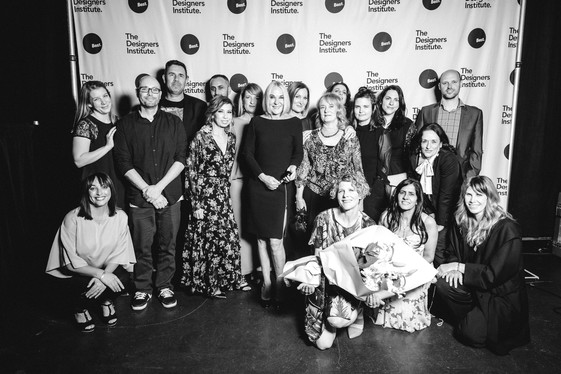The Designers Institute Black Pin for Outstanding Achievement is given to the individual who has made a lasting contribution to the design profession and to design in general.
Introduction

Q+A: Mike Barrett talks to Annie Dow PDINZ, director of Dow Goodfolk
Hi Annie, shall we take a quick blast through the past before we get around to your thoughts about the present and future? You’re originally from the UK, aren’t you?
Yes, that’s right. Let’s just say my father was a big influence in my life. The family immigrated to New Zealand. My father brought engineering, display sign & neon sign skills to the country. He set up his own business, in signs and displays, prominently known back in the 70’s,80’s and still know today as The Display Group. Whilst my father was a big influence to me, he was also a very traditional, old school thinking Englishman. In his mind, my brothers who were in the business as myself , were going to be the ones that were left the assest. One day I proposed that I’d like a slice of the action as well. He wouldn’t have a bar of it. As much as I loved him, that was an archaic & unjust mentality. I certainly wasn’t hanging around as second fiddle, so I bailed for the classic o/s trip.
Sounds like an early crack at smashing the patriarchy. What happened next?
I hightailed it back to the UK, and then started to freelance at legendary studios like Pentagram. I worked at Billy Blue in Sydney on the journey over. I really started to gather experience and a love of a 3D, working with my father and other design studios, specialising in this discipline. The experience of designing display stands and rendering visuals for cosmetic companies, designing packaged consumer goods and making mock ups, I started to feel very at home. I have never rated myself as a strong designer, but I’ve always had the vision of what something should look like, how it should fit into it’s world it will live in. Someone once told me, I had the art of a distinct intuition & a great mind, mixing logic & the design magic – an understanding of commercial reality in branding. Packaging suddenly became my new love in London.
What appealed to you about it?
I loved that you had a small space to work with, like a mini poster, that’s a silent sales tool. That’s where my commercial brain kicked in. I came back to New Zealand, as my father was turning 70 – the main motivation to return home. I am not sure I intended to stay here. However other things were in store for me. Within a week of being here, I met the late Greg Dow and my heart & life took a big turn.
Greg had been in the advertising world and we certainly had a great deal in common. I mentioned to him once, how no many design companies were focused on FMCG in NZ and it was a true speciality in the UK & Europe. It’s a love I’ve kind of adopted from the UK. Greg loved any challenge and so seeing the gap I had identified, Dow Design was born. We both had different skills to bring to the business partnership, never once questioning working & living together.
And what were they like those early days? We must be in the early’90s, right?
Greg and I were very competitive together. For us it was the chase of building great business relationships. I did design in the early days but as we got a reputation and busier, I quickly got off the tools and we hired designers, way more talented than me. We became well known for as packaging designers and word quickly spread. We had the lion’s share of the big accounts. Heinz Watties, Tegel, NZ Dairy Foods, (formerly Fonterra) Cerebos Greggs, Hellers & DB…..to name a few. This was the halcyon days in the design & advertising world. Things were buzzing, marketing teams were large and we continued to add further skills & processes to our business offer.
When did Greg pass away?
Greg passed away in 2007. At that time, we were in the middle of due diligence to sell to an American company. It promised to be a great deal – had Greg not died, I would be telling a different story today.
Greg was a property investor on the side, but this had became his passion. He liked to renovate old villas, so I imagine with a business sale and renovating houses, it would all look different. However the sale got taken off the table for a year and then the GFC hit. When the deal came back it looked very different and by then I had decided then I still had a passion for the business and walked away from the sale. For me, it was about having a purpose. And here I am today. I created Brother Design, a secondary arm, as we won the Foodstuffs Pam’s account. Brother continues today and have built their own reputation, as my sister business. I acquired Goodfolk, as a digital arm and rebranded to Dow Goodfolk.

Would you describe yourself as reasonably nimble then, with an ability to change focus quickly and take opportunities where you perceive them?
We are very nimble, through adversity and many challenges thrown at me, I have learnt to embrace change.. Greg in the office, right in front of me, that is something that you never get over, but you learn to live through. I’ve had to learn very quickly to reset, restructure & reposition many times in life. I believe one thing that stands our business in good stead is we have a very acute balance of commerce and design.
To rewind a little – you said that you’re not the world’s best designer, but the understanding of what design is has broadened out. Design is also assembling teams, putting the right people together.
That’s the thing for me. I know my capabilities. I think I have learnt to be an incredible negotiator. I also think that in this game you have to have a hell of a lot of integrity in the New Zealand design market. I think you have to act with good faith. Obviously, you have to deliver great design, but I think you have to value yourself. What I have found is that as an industry, we undervalue what we do. That delivery of value, I think, is really important, and I’ve seen the design industry commoditise itself to it’s detriment.
What do you mean by that?
There are healthy budgets in the rest of the world and I know often due to the size of the country. But my firm belief is we have not helped ourselves in the NZ design scene, by not placing true value on what we create for the NZ business economy.
What else is important, as you reflect Annie?
Reputation to me is very important. Integrity is very important. Delivering design excellence is very important. Being specialised is very important. As I reach another milestone in age next year, I am extremely proud of what I have contributed to the NZ design landscape. I am not ready to hang up the hat just yet, as I thoroughly enjoy what we create and how we build strong NZ brands & businesses. It’s a big buzz.
It’s interesting that you’ve seen the highest of the highs and the…
Lowest of the lows, I know. It’s really interesting. I still believe that every single project you approach it is critical to get the creative absolutely right for that brand. I don’t like it when creative is dumbed down, it frustrates me and so I always try to have that value conversation with clients about, “Don’t think short term, think long term. Get it right so that it contributes to building your asset.” So many businesses spend so much money setting up production and logistics, their distribution chains, even their franchise models or whatever game they are in – and then they look at creating brand last. Yet brand is the glue that holds it all together.
Why do you think that is? Surely, we’ve become more intelligent as time goes on, more familiar with the processes required to take a product to market?
I’ve thought about this a lot. Design has become a very common conversation for so many people, and there are many quick shortcuts to creating brands all at your fingertips via Uncle Google. People often only see the tip of the iceberg. They don’t see the strategic foundations well laid beneath. I continually educate people, talking about getting the brand-heart right. Writing the strategy at the very beginning is the most important piece of work.
We talk about what makes a good designer, but what then do you think makes a good client?
A good client is open and can listen. I do feel design is all about people, and the design output is only often as good as the person that’s guiding it. They can be anxious of the process, anxious of the money they’re going to spend. They might start out the process by going, “But what if I don’t like it?” Well, this is why we have aprocess. Remove all subjectivity and it’s very objective, very measured.
I do like to have partnerships that truly understand brand. If I look back at the history of the partnerships we’ve had, they are enduring and many for at least 15-20 years.
I was just thinking about Pam’s actually, in these days of click and collect shopping. It’s interesting with a brand like Pam’s and the journey it’s gone on. It’s changed so much since the early days of the budget brand.
In the last decade Pam’s has grown immensely and is a loved NZ brand. It’s a really big part of the Foodie’s business. A smart team, when you work with retailers, you learn an awful lot about trading. As a team we have honed our skills even more through these relationships. Its a great point of difference.
Before Covid, I would have asked you for your thoughts on the future, or ambitions, but it is of course more unwritten than normal.
It’s really unwritten. We are all asking ourselves the same thing. Live in the now, learn from this experience and become more thoughtful about our approach in business now.
I will forever love and relish the opportunity to build our design community, to build Kiwi exporters that have an authentic brand presence on the global stage.
